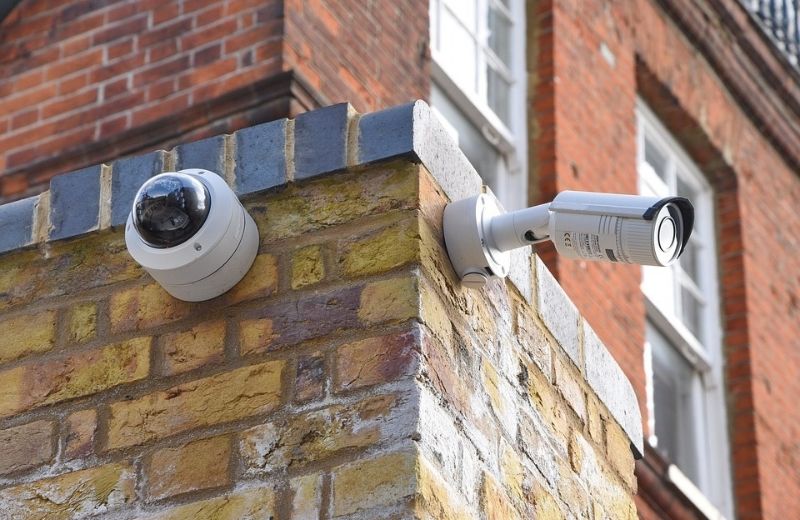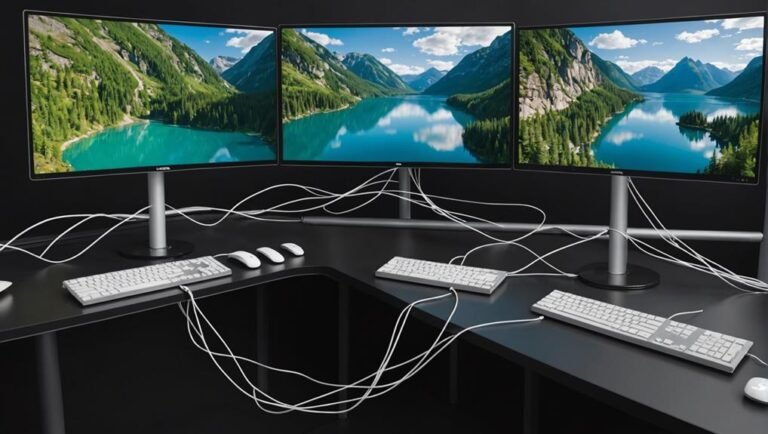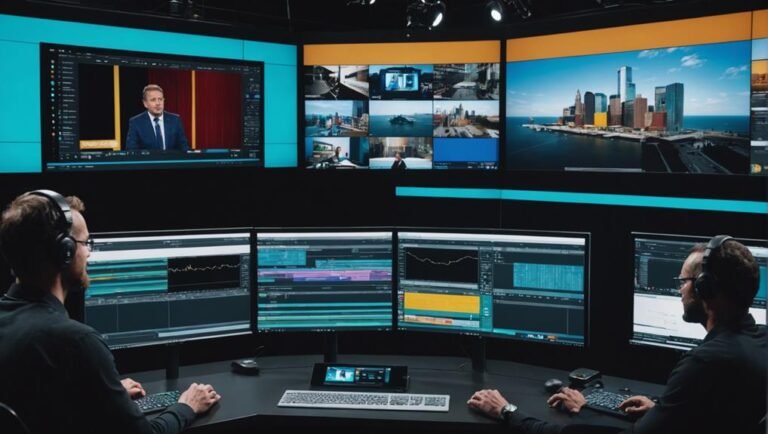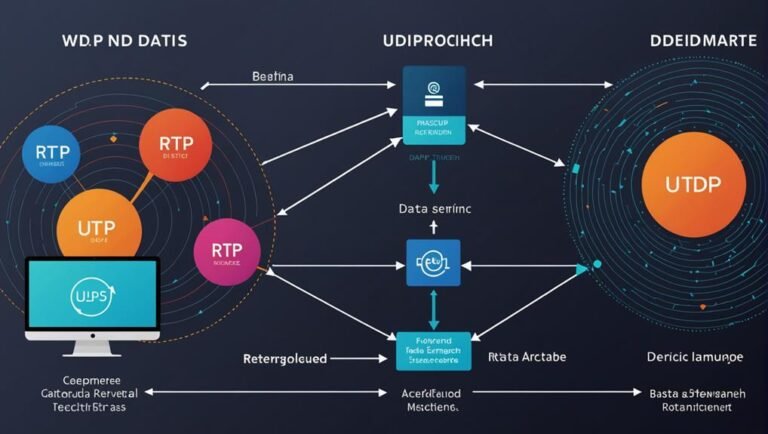When choosing between CCTV bullet and dome cameras, you’ll want to take into account design, installation, and specific needs. Bullet cameras have a visible, cylindrical shape that deters intruders and are easier to mount, making them ideal for long-range outdoor monitoring. Dome cameras, with their sleek, circular design, blend into interiors and offer a broad view with fewer blind spots, though they require more careful positioning. Both types provide high-quality images and night vision, but bullet cameras excel in durability and long-distance clarity. Dome cameras are more vandal-resistant. Interested in finding the best fit for your environment and security needs?
Design and Appearance
When comparing CCTV bullet and dome cameras, their design and appearance are the most noticeable differences. Bullet cameras have a long, cylindrical shape that resembles a rifle bullet. This design makes them easy to spot, which can act as a strong deterrent to potential intruders. If you want to make it clear that your property is monitored, bullet cameras are a solid choice. They’re typically mounted on walls or ceilings, making them versatile for various settings.
Dome cameras, on the other hand, have a sleek, circular design that blends effortlessly into any environment. Their discreet appearance makes them ideal for indoor use, especially in places where you don’t want the camera to stand out. The dome design also makes it harder for someone to tell which direction the camera is pointing, providing a sense of all-around surveillance.
If you’re someone who values both security and aesthetics, the choice between bullet and dome cameras can impact the overall feel of your space. Bullet cameras scream security, while dome cameras offer a subtler approach. Your ideal choice depends on whether you prefer a bold statement or a more concealed presence.
Installation Process
Installing CCTV bullet and dome cameras involves different steps and considerations based on their distinct designs. When installing bullet cameras, you’ll find them easier to mount due to their cylindrical shape. They often come with a mounting bracket that lets you adjust the angle effortlessly. You can attach them to walls or ceilings, but make sure they’re securely fastened to withstand weather conditions if installed outdoors.
Dome cameras, on the other hand, offer a bit more flexibility in placement. Their compact, dome-shaped design allows them to blend seamlessly into any environment, making them ideal for indoor use. You’ll typically mount them on ceilings, but some models can also be wall-mounted. The installation might require a bit more effort since you need to make sure the dome covers the camera lens properly and that the camera is aligned correctly for the best coverage.
Both types require running cables to a power source and a recording device, so be prepared to handle some wiring. Wireless options exist, but you’ll still need to manage power cables. Don’t forget to test the cameras after installation to confirm they’re capturing clear images and functioning as intended.
Coverage Area
Bullet and dome cameras each offer unique advantages with respect to coverage area, catering to different surveillance needs. When you’re looking to monitor a wide-open space like a parking lot or large backyard, bullet cameras are your go-to. Their design allows for longer range and they’re often equipped with varifocal lenses, letting you zoom in on specific areas without losing detail. This makes them perfect for keeping an eye on expansive areas where every detail matters.
On the other hand, dome cameras excel in providing a broad, all-encompassing view, making them ideal for indoor settings like retail stores or office spaces. Their 360-degree coverage means fewer cameras are needed to cover the same area, giving you more freedom in positioning them. Plus, their unobtrusive design blends seamlessly into the environment, making them less likely to be tampered with.
Image Quality
Whether you’re prioritizing clarity or detail, image quality is a crucial factor to take into account when choosing between bullet and dome cameras. Both types offer high-resolution options, but each has distinct advantages. Understanding these can help you make a more informed decision.
Bullet cameras are known for their long-range capabilities and are great for capturing detailed images from a distance. Dome cameras, on the other hand, offer a wider field of view, making them ideal for monitoring larger areas with fewer blind spots.
Here are four key points to keep in mind:
- Resolution: Bullet cameras often come with higher resolution options, providing clearer images over long distances. Dome cameras also offer high resolution but are optimized for broader coverage.
- Low Light Performance: Bullet cameras usually excel in low-light conditions thanks to their larger lenses. Dome cameras are improving in this area but may need additional lighting for best performance.
- Field of View: Dome cameras typically offer a wider field of view, which is perfect for monitoring open spaces. Bullet cameras focus on narrower, more targeted areas.
- Flexibility: Bullet cameras can be easily adjusted to focus on specific points, while dome cameras provide a more general surveillance solution.
Choose the camera that aligns with your specific needs for the best image quality.
Durability and Weather Resistance
When considering durability and weather resistance, it’s essential to understand how each camera type stands up to various environmental conditions. Bullet and dome cameras excel in different ways, and knowing these differences helps you pick the right one for your needs.
Bullet cameras are generally more rugged and can handle harsh weather conditions better. They often come with a weatherproof casing, making them ideal for outdoor use. Dome cameras, on the other hand, offer a more discreet profile but may not be as robust in extreme weather. However, many dome cameras are designed to be vandal-resistant, making them a good choice for areas prone to tampering.
Here’s a quick comparison to help you decide:
| Feature | Bullet Camera | Dome Camera |
|---|---|---|
| Weatherproof | High | Moderate |
| Vandal Resistance | Moderate | High |
| Installation Location | Outdoor | Indoor/Outdoor |
| Maintenance | Easier | Slightly Complex |
| Aesthetic Appeal | Moderate | High |
Both camera types have their pros and cons. Bullet cameras are your go-to for enduring harsh weather, while dome cameras offer better protection against tampering. Your choice depends on what you value more: weather resistance or vandal resistance.
Cost Comparison
Cost is a pivotal factor when deciding between bullet and dome cameras for your surveillance needs. Both options have their own pricing structures, and understanding these can help you make a more informed choice without feeling restrained by budget constraints.
Here’s a quick breakdown:
- Initial Purchase Price: Bullet cameras generally cost less upfront compared to dome cameras. If you’re looking to set up a basic system, bullet cameras might be more wallet-friendly.
- Installation Costs: Dome cameras can sometimes be pricier to install due to their design and placement complexity. Bullet cameras, being more straightforward, often reduce installation expenses.
- Maintenance Costs: Bullet cameras are usually easier to maintain because of their accessible design. Dome cameras, however, might require more frequent upkeep, especially if placed in high-traffic areas.
- Long-term Investment: Dome cameras, with their discreet and vandal-resistant nature, might save you money in the long run by reducing the need for replacements and repairs.
Balancing these factors is key. Your choice between bullet and dome cameras should align with your financial freedom and specific surveillance requirements. Weighing the costs against the benefits helps you get the most value out of your investment.
Suitable Environments
While cost is an important factor, it’s also vital to contemplate the environments where bullet and dome cameras excel. Bullet cameras are perfect for outdoor settings. Their cylindrical shape and long range make them ideal for monitoring large areas like parking lots, backyards, or driveways. You can mount them on walls or ceilings, and their weather-resistant design guarantees they withstand the elements. If you’re looking to keep an eye on a wide-open space, a bullet camera is your go-to.
On the other hand, dome cameras thrive in indoor environments. Their sleek, unobtrusive design makes them less noticeable, which is great for maintaining the aesthetic of your home or office. These cameras are often installed on ceilings, providing a broad field of view. Dome cameras are particularly effective in monitoring hallways, lobbies, and retail stores. They offer flexibility and can cover multiple angles without needing to be repositioned.
Choosing the right camera boils down to where you need surveillance. Bullet cameras are your best bet for outdoor security, while dome cameras offer versatile indoor monitoring. Evaluate your specific needs and select the camera type that guarantees your freedom and peace of mind.
Deterrence Factor
A significant advantage of bullet cameras is their visible presence, which can act as a strong deterrent to potential intruders. When someone sees a bullet camera, they know they’re being watched, and that alone can make them think twice about committing a crime. The design of bullet cameras is more noticeable compared to dome cameras, making them ideal if you want to send a clear message that your property is under surveillance.
Here are four key reasons why bullet cameras excel in deterrence:
- Visible Design: Their elongated, noticeable shape stands out, making it clear that surveillance is in place.
- Immediate Recognition: Intruders can quickly identify bullet cameras, which can discourage them from attempting any unlawful activity.
- Ease of Direction: You can easily point bullet cameras in specific directions, ensuring that high-risk areas are covered and visibly monitored.
- Psychological Impact: The obvious presence of a security camera can create a psychological barrier, reducing the likelihood of criminal behavior.
Night Vision Capabilities
Equipped with infrared LEDs, both bullet and dome cameras provide robust night vision capabilities, guaranteeing clear footage even in low-light conditions. This means you won’t have to worry about the nighttime compromising your security. These cameras switch to night mode automatically as the ambient light diminishes, capturing details that would otherwise be missed.
Bullet cameras, with their elongated shape, often house more powerful IR LEDs, giving them an edge in long-range night vision. If you’re looking to cover expansive areas like backyards or parking lots, bullet cameras can be your go-to. They excel at pinpointing specific spots far away, making sure nothing slips by unnoticed.
On the other hand, dome cameras offer a wide-angle view that’s perfect for monitoring large indoor spaces or entrances. Their design allows for discreet placement, and they can blend seamlessly into their surroundings while still providing sharp images in the dark. They work well for areas where aesthetics and coverage are key.
Regardless of your choice, both types ensure you maintain control over your environment 24/7. With night vision, your freedom to feel secure doesn’t end when the sun goes down. It’s all about finding what suits your specific needs best.
Maintenance Requirements
When it comes to maintenance, both bullet and dome cameras require periodic cleaning and inspection to guarantee peak performance. You want your surveillance system to work flawlessly, right? So, let’s focus on what you need to keep an eye on.
- Lens Cleaning: Dust, dirt, and grime can accumulate on the lens over time. Use a microfiber cloth and lens cleaner to wipe it regularly. This keeps your footage clear and sharp.
- Checking Connections: Make certain all cables and connectors are secure. Loose connections can lead to intermittent signal issues, which you definitely don’t want.
- Firmware Updates: Manufacturers often release updates to improve performance and security. Make sure you’re not running outdated software by checking for updates periodically.
- Physical Inspection: Look out for any visible damage or signs of tampering. This is essential for maintaining your camera’s integrity and overall security.
Bullet cameras are generally easier to clean because their design is straightforward. Dome cameras, however, might require a bit more effort due to their enclosed structure. But don’t let that deter you; both types are built to last with a little care. By following these tips, you’ll ensure your cameras continue to provide the security you need without any hassle.
Frequently Asked Questions
Do Bullet and Dome Cameras Have Different Power Consumption Levels?
You might wonder if bullet and dome cameras have different power consumption levels. Typically, they don’t. Both types generally consume similar amounts of power, depending on their features and specifications. Choose based on your needs.
Can Bullet and Dome Cameras Be Integrated With Smart Home Systems?
Yes, you can integrate both bullet and dome cameras with smart home systems. Bullet cameras offer a sleek, modern look, while dome cameras provide a discreet option. Both types can enhance your home’s security and automation freedom.
Are There Any Privacy Concerns With Bullet Versus Dome Cameras?
You might worry about privacy with both bullet and dome cameras. Dome cameras offer more discretion since they’re harder to notice, but with either, make sure you’re aware of where they’re pointing to respect everyone’s privacy rights.
How Do Bullet and Dome Cameras Handle Audio Recording?
You’ll find that both bullet and dome cameras vary in their audio recording capabilities. Some models include built-in microphones, while others may need external mics. Always check the specs to guarantee your freedom from unwanted audio limitations.
Do Bullet and Dome Cameras Come With Mobile App Support?
You’ll be glad to know that many cameras come with mobile app support. This feature lets you monitor your property from anywhere, giving you the freedom and flexibility to stay connected on your own terms.



